Term
Image
Definition
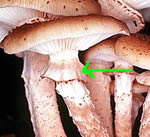
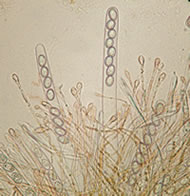
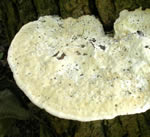
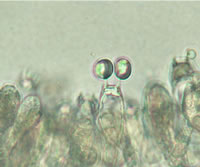
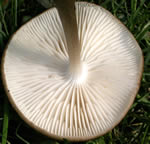
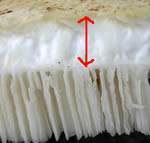
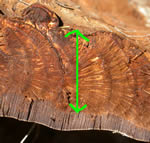
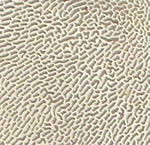
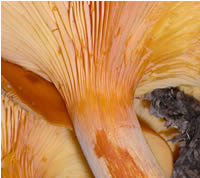
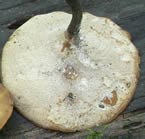
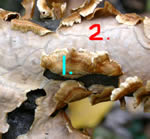
labeled number 2 is effused.
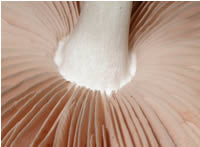
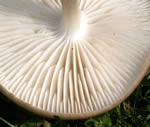
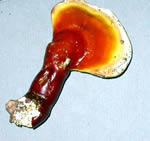
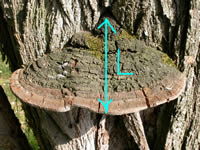
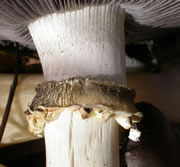
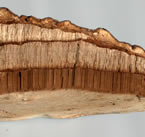
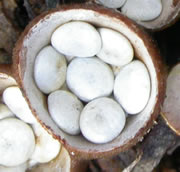
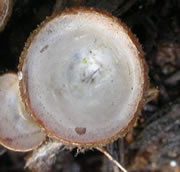
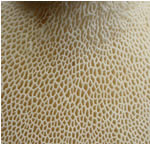
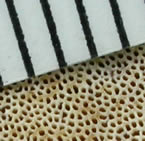
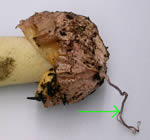
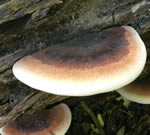
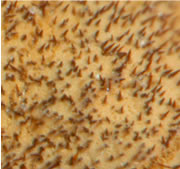
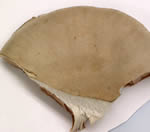
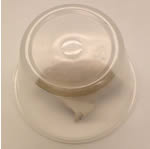
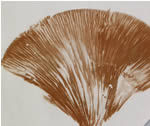
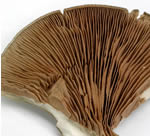
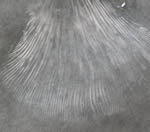
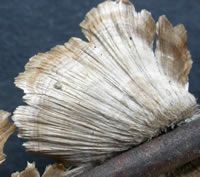
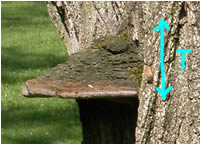
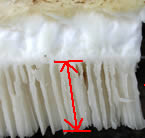
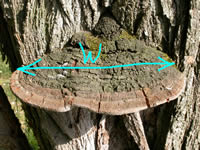
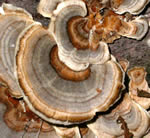
As with any specialized area of study, mycology uses specialized words to convey specific meanings. While highly technical language is minimized in the keys, the user should understand the specialized terms that are used. Taking the time to do this will greatly facilitate the use of the keys and understanding of the species descriptions. The specialized terms found in the keys are defined here and, in cases where a picture is worth a thousand words, the term is illustrated as well.
Term |
Image |
Definition |
| annulus |  |
The ring on the stem of some mushrooms, formed by the separation of the partial veil from the margin of the cap. |
| asci/ascus |  |
The microscopic sac-like structures which contain ascospores; ascus (singular), asci (plural). As observed in the picture to the left, many asci contain 8 ascospores. |
| ascocarp | The fruiting body, cup, sporophore, fructification, mushroom, etc., which bears asci. | |
| ascospore | The microscopic reproductive propagule formed via meiosis and formed within an ascus; fungi which form ascospores are called ascomycetes. See asci/ascus. | |
| azonate |  |
Without concentric bands of contrasting colors. An azonate cap surface is illustrated here by Perenniporia robinophila. Note that azonate does not mean the surface is featureless or smooth. The cap pictured here is quite rough, for example, but is azonate. |
| basidia/basidium |  |
Microscopic, often club-shaped structures bearing basidiospores on the outside; basidium (singular), basidia (plural). In this image, two basidiospores can be observed, each perched on a peg-like structure called a sterigma. The sterigmata are attached to the underlying basidium. |
| basidiocarp | The fruiting body, conk, sporophore, fructification, mushroom, etc., which bears basidia. | |
| basidiospore | The microscopic reproductive propagule formed via meiosis and borne on a basidium; fungi which form basidiospores are called basidiomycetes. See basidia/basidium. | |
| broad | Diameter of the cap of a gilled, non-sessile mushroom. See width. | |
| cap (pileus) | The structure that bears the hymenium. For example, in the gilled fungi the cap bears the gills underneath on which the hymenium is present. With the polypores, the brackets or shelves these fungi form are often called caps. See pileus. | |
| central |  |
Referring to a stem attached at the center of the cap or pileus. |
| coniferous | In the context of this key, these are trees which bear cones and not flowers. This group includes pines, firs, spruces, and hemlock. They are known as softwood species. | |
| context (flesh) |  |
The inner sterile hyphae of the cap or pileus; not the tubes, gills, etc. The white context (red arrows) of Polyporus squamosus is in striking contrast to the brownish context (green arrows) of Inonotus dryadeus. Note the relative thickness of tubes and context in the two species. |
 |
||
| daedaloid |  |
With elongate and sinuous pores, forming a maze-like pattern. |
| deciduous | In the restricted context of these keys and descriptions, deciduous refers to trees which form flowers and shed their leaves. This group includes oaks, maples, and many other broad-leaved trees. See hardwood, as a synonym. | |
| decurrent |  |
Gills that descend or run down the stem. |
| eccentric |  |
A stem not attached at the center of the cap or pileus; off-center as in the picture of the stipe of Polyporus varius. |
| effused | Spread out over the substrate without a regular form, no true cap or pileus is formed. See effused-reflexed. | |
| effused-reflexed |  |
A fruitbody spread out over the substrate and turned back
(reflexed)
at the margin to form a pileus (cap). In the pictured example
of Sterium complicatum,
the portion labeled number 1 is
reflexed and the portion labeled number 2 is effused. |
| fertile surface | The surface bearing the hymenium. The hymenium may cover the surface of gills or teeth or spines, or line the interior of tubes, or cover the upper surface of cup fungi. | |
| flesh (context) | The inner sterile substance of pileus or stipe exclusive of gills, spines, tubes, etc. See context. | |
| free |  |
Gills not attached to the stem. |
| fruitbody | The visible fungus structure attached to the substrate. The purpose of the fungus fruitbody is to produce spores and disperse them in the environment. This web site is a guide to fungi that form fruitbodies on wood. | |
| gills (lamellae) |  |
Plate or knife blade-like structures on the underside of the cap, often radiating from a point. Also called lamellae. The hymenium covers the gills. In this example the gills are attached, meaning they are attached to the stem. See free. |
| glabrous | A surface with neither hairs or scales. | |
| hardwood | In the context of this key, these are trees which form flowers. This group includes oaks, maples, and many other broad-leaved trees. See softwood. | |
| hymenium | The layer of basidia or asci; it lines the inside of the tubes of polypores, it covers the surfaces of gills, spines, clubs, etc. or covers the upper surface of cups and saucers. | |
| hypha | One of the elongated cells or filaments of a fungus; hyphae (plural). | |
| KOH | A 3-5 % solution of potassium hydroxide in water; used to test for color changes. | |
| lamella | A leaf-like plate or knife blade-like plate of tissue on the undersurface of the cap; a gill. See gill. | |
| lamellate | Composed of lamellae or gills. | |
| lateral |  |
A stem attached to one side of the cap or pileus. |
| length/long (L) |  |
In sessile forms, the projection of the pileus out or away from the substrate. |
| lignicolous | Fungi which utilize wood as a substrate. | |
| mycelium | The whole mass of hyphae forming the "body" of a fungus. | |
| NAMA | ||
| NEMF | Northeast Mycological Federation | |
| partial veil (annulus) |  |
A membrane extending from the stem to the margin of the cap and covering the gills; when it ruptures it usually leaves a ring on the stem. See annulus. |
| perennial |  |
Lasting for more than one year; perennial polypores show more than one layer of tubes, typically one layer for each year. The polypore in the picture has three layers of tubes. |
| peridiole |  |
The "eggs" in a bird's nest fungus are the peridioles. Basidiospores are formed within the peridioles. |
| peridium |  |
An outer layer of tissue that encloses the spore-producing tissues of certain fungi. For example, the empty "nest" of the bird's nest fungi pictured here is the peridium. So, too, is the outer wall of a puffball fungus or the sac-like "egg" out of which a stinkhorn bursts. |
| pileate | Having a cap or pileus. | |
| pileus/pilei | The cap-like portion of a gilled mushroom, with or without a stem; the bracket of polypores. The pileus bears the hymenium (fertile surface) on its lower surface. See cap. | |
| polypore | A fungus in which the lower surface of the fruiting body bears tubes that open downward as pores. The pores, or tube openings, are often conspicuous but use a hand lens before deciding there are no pores. | |
| pores |  |
The openings of the tubes covering the lower surface of a polypore fungus. |
| pores per mm |  |
The number of pores that fit within the distance of one millimeter. In the illustrated example Polyporus varius, the ruler markings are 1 mm apart. This polypore has approximately 5 pores per mm. A single pore of other species can be over 1 mm in diameter. |
| poroid | Having pores or, in some cases, pore-like depressions formed by folds of tissue. | |
| pubescence | Covered with short, soft, downy hairs. | |
| reflexed | A basidiocarp turned up or back to form a cap or pileus. See effused-reflexed. | |
| resupinate | Completely flattened, appressed to the substrate, without cap or stem. See effused and effused-reflexed. | |
| rhizomorph |  |
A strand or cord of compacted hyphae, visible to the naked eye as in the thread-like structure at the green arrow. |
| serrate | A margin with teeth like a saw blade. | |
| sessile |  |
A fruit body lacking a stem and seen to be broadly attached to the wood substrate. |
| setae |  |
Small spine-like structures found within the tissues or on the surfaces of certain fungi. A hand lens (or a microscope in many species) is required to see them. |
| sinuous (daedaloid) | Crooked, curved, or winding; of pores with curved walls. See daedaloid. | |
| softwood | In the context of this key, these are trees which bear cones and not flowers. This group includes pines, firs, spruces, and hemlock. See hardwood. | |
| spore print |  |
A spore print is the deposit on paper of hundreds of thousands of spores from a fruitbody allowed to rest undisturbed on paper for a few hours. The picture shows a portion of a cap placed gill surface down on white paper. Whole caps can also be used. |
 |
Here, the cap is covered for several hours. Wax paper can also be used to cover the cap. If wax paper is used, make sure the edges are pressed down to slow the drying of the mushroom and to eliminate drafts which can interfere with the spore deposit. | |
 |
After removing the cap, dark deposits of spores are observed that correspond to the spaces between the gills of the cap. | |
 |
Here's a view of the gills to show how the spore print above corresponds with the pattern of the gills. | |
 |
In this photograph, a white spore deposit is pictured on black paper. White paper can be used exclusively for spore prints because white spore prints can be seen on white paper. | |
| stipe, stipitate | A fruitbody with a stem. | |
| striate |  |
Marked with parallel or radiating lines. This picture is of the striate cap of Stereum striatum. |
| substrate | The substance upon or in which a fungus grows. | |
| terrestrial | Growing on the ground. Note that some fungi included in these keys may appear terrestrial but are in reality growing on buried wood . | |
| thick (T) |  |
In sessile forms, the distance from top to bottom at point of attachment. |
| tomentose | Covered with dense matted hair or wool-like pubescence. | |
| tubes |  |
The cylindrical hollow structures typical of fungi called polypores. In this picture of Polyporus squamosus, the red arrows indicate the tubes which have been longitudinally cut open to reveal the hollow interiors. The hymenium lines the inside of each tube. |
| volva | A cup-like or sac-like structure at the base of the stem of a fruit body. It represents the bottom portion of a membrane or universal veil that once enclosed the entire mushroom. This picture is of Amanita jacksonii which is not a wood-inhabiting species. It does, however, have a very good example of a volva. | |
| width/wide (W) |  |
In sessile forms, the length of horizontal attachment to substrate. |
| zonate |  |
Marked with concentric bands of contrasting colors. |
This page © 2025 by Gary Emberger |